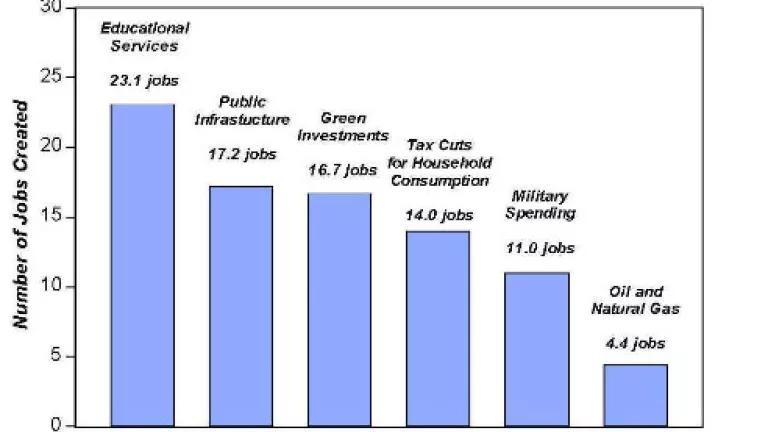
One of the most bizarre arguments made by the "let's not solve global warming" crowd is that doing so will hurt the poor (about whom, mysteriously enough, these voices seem to remain pretty unconcerned when almost any other topic is on the agenda.)
But according to one of the leading experts on macroeconomics and conditions for low-wage workers in the U.S., this thinking is outdated and wrong. Testifying at a recent hearing before the House Committee on Education and Labor, Dr. Robert Pollin, of the Political Economy Research Institute, argued that "there is no reason at all to delay taking action now to fight global warming" and went on to make the case that "green" investments would be one of the smartest economic stimulus strategies that Congress could pursue.
Exhibit 1 in Pollin's argument is the job creation potential of different kinds of investments. According to analysis using the U.S. Department of Commerce's own economic data, investments in clean energy (energy efficiency and renewable energy) create more jobs per dollar invested than tax cuts, military spending, or oil and natural gas.
Therefore, in order to get the most bang for the taxpayers' bucks, Congress should invest money in renewable energy, in education, and in retrofitting buildings and other infrastructure for maximum energy efficiency. Such a plan will benefit both the environment and American workers.
But where would the money come from? In the near-term, Congress could pay for this just like it would pay for any other stimulus package: deficit spending. Over the long-term, Pollin says, "the primary new source should be revenues generated through a carbon cap-and-trade program such as that sponsored last year in the U.S. Senate by Senators Boxer, Lieberman, and Warner. A cap-and-trade program, such as Boxer/Warner/Lieberman would set limits on carbon-dioxide emissions and require companies to obtain permits to release carbon into the air. The government would generate revenues by charging businesses to obtain the carbon-emitting permits. Credible estimates as to how much the government could raise through such a program range widely, between $75 and $200 billion."
But where does climate regulation fit in? As our Andy Stevenson notes, the "cap and trade" proposals that have been before Congress in recent years would, if passed, produce revenue which could be put into research and development of renewable energy sources as well as into retrofitting existing infrastructure. Perhaps more importantly, a cap-and-trade system would encourage the private sector to move the economy in a greener direction: to join with labor, scientists, government, and ordinary citizens in building a new, greener foundation for prosperity in America.
